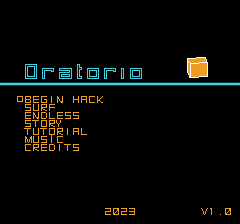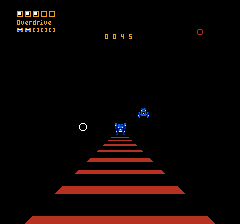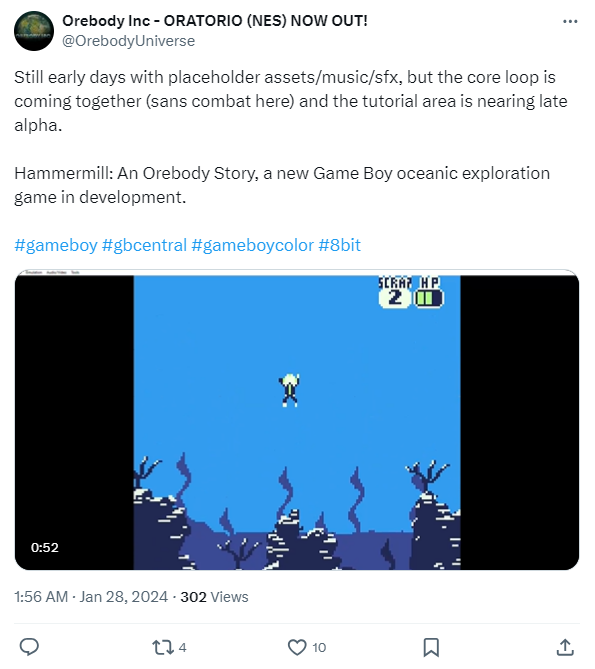Indie Retro Homebrew Showcase Interview: Find the rhythm with Oratorio!
For our third feature of our Indie Retro Homebrew Showcase Interview series, we interviewed the maestro behind the rhythm and action game Oratorio, John Vanderhoef!
Get your tempos and shooters ready as we uncover the stories as he was developing the game! Read down below on how our interview went!
How was your game born?

I had been playing with the idea of making a NES game where player actions create the soundtrack for a while. Then, in August 2022, NESMaker held its third Byte-Off competition, a kind of extended game jam for NESMaker developers. It was at that point where I drew inspiration from one of my favorite games of all time, Rez, and decided to make an homage to that game, and its spiritual successor, Child of Eden, on the NES. I collaborated with Jordan Davis (Space Raft, The Storied Sword) on an initial proof of concept demo for that competition and ended up winning what is called The Wombat Award for the weirdest, out-of-left-field entry. I then moved forward to finish the game since I was already in love with it.
What was development like?
Development was initially tricky for a number of reasons. I’m not very good at programming or music. Jordan handled the music, so I just had to rely on the NESMaker community to help me figure out how to make the programming work. Under the hood, what we’re essentially doing is running a unique composition constantly in the background but keeping two of the sound channels muted until a corresponding action occurs on screen – the player fires or an enemy gets hit, for instance. Anyway, long story short, that was the trickiest part. Once that was in place, it was actually a lot of fun to create pseudo-3D backgrounds representing “cyberspace” environments and designing the waves of enemies for each area.
What did you learn about yourself through this game?
Nothing I didn’t already know from the previous NES games I’ve developed. I suppose I further developed my love of messing around with pixel art. I’m no artist, but I have a strong aesthetic perspective, and this game, above all of my others, allowed me to cultivate and hone in on that a bit more.
What makes this game special?
While there are better pseudo-3D games on the NES, and certainly there are music/rhythm games, there is almost nothing else like Oratorio on the console. There is a game called Otocky for the Famicom Disk System. I learned about that project from Fei at Broke Studio after I was already developing Oratorio. It’s great! That’s more of a scrolling shooter, but has a similar concept of all player actions contributing to the soundscape. I recommend that people check that game out. In any case, Oratorio is nonetheless a very unique game on the system that combines unorthodox visuals, a unique interactive soundtrack, fast-paced and addicting shooting galleries, and a cyberpunk hacking narrative that engages with pressing issues of our times like global warming, the rapid extinction of species, and the increasing dominance of global tech conglomerates in our lives.
How does sound play a role in the game?
Hopefully this is already clear given my previous answers. Haha. Oratorio offers an interactive soundtrack. Players literally create the soundtrack through their actions, like firing their projectile and hitting enemies. It’s an almost visceral connection with the soundscape of the game and creates a multi-sensory experience that can easily slip into a state of flow. It’s like an interactive album.

What games influenced this one the most?
The biggest influences were Rez, Child of Eden, and Thumper. Of course, like any game, there are myriad other inspirations from across gaming history. Astute players may find some easter eggs or homages in there to other games.
Any fun stories or wild moments during development?
Nothing too crazy. But I guess this is a good moment to shout out the artist for the game’s NES box art. Matthew Warren Lee produced an original oil painting for the cover. The image used was literally a cleaned up scan from an actual painting. Matt is also the artist that did the cover for Orebody: Binder’s Tale. Honestly, I consider Matt’s cover paintings to be as vital as my designs or Jordan’s excellent and unique compositions.
Do you think preserving older gameplay mechanics in new games is important?
If a game mechanic works – if it remains engaging and, for lack of a better term, fun, then older gameplay mechanics should absolutely be preserved. And, of course, many are to this day, even if they’ve been iterated on over and over again.
But I would also argue that the opposite is true for retro development. That is, I think retro devs can and should look at what mechanics have developed over the entire history of games and think about how they might be implemented on older consoles. It’s an amazing time to be a player and/or a developer. We can go from the Atari to the NES to virtual reality in a single afternoon. And there’s so many talented people working all over the world.

What's your favorite memory as a gamer?
That’s a tough one. Some special moments were receiving my first NES in 1990 (I know, pretty late), getting Ocarina of Time for Christmas in 1997, staying home from school to pick up Shenmue on day one for the Dreamcast. I could go on. I loved sleepless nights playing Diablo 2 and Counterstrike on my terrible PC. I remember buying an Xbox 360 in 2007 and grabbing BioShock and The Orange Box that Fall and just being in absolute heaven. Both BioShock and Portal remain experiential pillars in games for me. Most recently, my favorite memory has been slowly introducing my young son to video games. He’s already a Zelda fanatic!
Who will enjoy this game the most?
Retro players who enjoy unique homebrew experiences. Fans of rhythm action shooters like Rez. Music fans in general. At least, I hope they will enjoy it!
Bottom line, why must someone play this game?
It’s a unique rhythm action shooting game experience in the NES homebrew library, which is full of extremely unique and amazing work. From the gameplay to the visuals to its interactive soundtrack, it’s a singular experience that I hope every NES player appreciates. The game features four main Areas, each with its own audio track, that can be played in any order and an extra long final fifth Area with a unique track that becomes accessible once the other four are finished. There’s also an Endless mode with unique screens that provides additional challenges and experiences. It’s a robust, complete package.
How do you want this game to be remembered?
As a fun and engaging interactive music album – and as a game people can return to and zen out whenever they want.
What's next?
I’m currently developing a Game Boy game called Hammermill: An Orebody Story. It takes place in the same universe as Binder’s Tale but tells a very different story following a new set of characters. Players will explore the alien oceans of the planet Orebody in this action adventure title that combines simple ship combat with underwater exploration.

Anything else you'd like to add?
Thanks for the opportunity, Mega Cat Studios!
-



